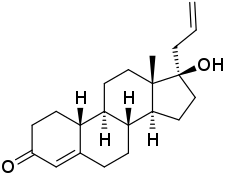 | |
| Clinical data | |
|---|---|
| Other names | Allylnortestosterone; Allylestrenolone; Allylnandrolone; 3-Ketoallylestrenol; 17α-Allylestr-4-en-17β-ol-3-one; Allylestrenolone |
| Drug class | Progestogen |
| Identifiers | |
| |
| CAS Number | |
| PubChem CID | |
| ChemSpider | |
| UNII | |
| Chemical and physical data | |
| Formula | C21H30O2 |
| Molar mass | 314.469 g·mol−1 |
| 3D model (JSmol) | |
| |
| |
17α-Allyl-19-nortestosterone, also known as 3-ketoallylestrenol or as 17α-allylestr-4-en-17β-ol-3-one, is a progestin which was never marketed.[1][2][3][4] It is a combined derivative of the anabolic–androgenic steroid and progestogen nandrolone (19-nortestosterone) and the antiandrogen allyltestosterone (17α-allyltestosterone).[1][2][3] The drug is a major active metabolite of allylestrenol, which is thought to be a prodrug of 17α-allyl-19-nortestosterone.[4][5]
17α-Allyl-19-nortestosterone has 24% of the affinity of ORG-2058 and 186% of the affinity of progesterone for the progesterone receptor, 4.5% of the affinity of testosterone for the androgen receptor, 9.8% of the affinity of dexamethasone for the glucocorticoid receptor, 2.8% of the affinity of testosterone for sex hormone-binding globulin, and less than 0.2% of the affinity of estradiol for the estrogen receptor.[6][7] The affinity of 17α-allyl-19-nortestosterone for the androgen receptor was less than that of norethisterone and medroxyprogesterone acetate and its affinity for sex hormone-binding globulin was much lower than that of norethisterone.[6] These findings may help to explain the absence of teratogenic effects of allylestrenol on the external genitalia of female and male rat fetuses.[6]
| Compound | PR | AR | ER | GR | MR | SHBG | CBG | |
|---|---|---|---|---|---|---|---|---|
| Allylestrenol | 0 | 0 | 0 | 0 | ? | 1 | ? | |
| 17α-Allyl-19-NT | 186 | 5 | 0 | 10 | ? | 3 | ? | |
| Values are percentages (%). Reference ligands (100%) were P4 for the PR, T for the AR, E2 for the ER, DEXA for the GR, aldosterone for the MR, T for SHBG, and cortisol for CBG. | ||||||||
See also
References
- 1 2 Colton FB, Nysted LN, Riegel B, Raymond AL (1957). "17-Alkyl-19-nortestosterones". Journal of the American Chemical Society. 79 (5): 1123–1127. doi:10.1021/ja01562a028. ISSN 0002-7863.
- 1 2 Miyake T, Pincus G (December 1958). "Progestational activity of certain 19-norsteroids and progesterone derivatives". Endocrinology. 63 (6): 816–824. doi:10.1210/endo-63-6-816. PMID 13609555.
- 1 2 Miyake T (3 February 2016). "Progestational Substances". In Dorfman RI (ed.). Methods in Hormone Research. Vol. 2 Bioassay. Elsevier. pp. 134–. ISBN 978-1-4832-7276-4.
- 1 2 McRobb L, Handelsman DJ, Kazlauskas R, Wilkinson S, McLeod MD, Heather AK (May 2008). "Structure-activity relationships of synthetic progestins in a yeast-based in vitro androgen bioassay". The Journal of Steroid Biochemistry and Molecular Biology. 110 (1–2): 39–47. doi:10.1016/j.jsbmb.2007.10.008. PMID 18395441. S2CID 5612000.
- ↑ Zeelen FJ (1990). Medicinal chemistry of steroids. Elsevier Science Limited. pp. 108–109. ISBN 978-0-444-88727-6.
Other examples are allylestrenol (42), a pro-drug converted to the 3-keto analogue (43), which is used in the treatment of threatened abortion [78,79] and altrenogest (44), used in sows and mares to suppress ovulation and estrus behaviour [80]. [...] Progestins with a 17a-allyl side chain: (42) allylestrenol, (43), (44) altrenogest.
- 1 2 3 4 Bergink EW, Loonen PB, Kloosterboer HJ (August 1985). "Receptor binding of allylestrenol, a progestagen of the 19-nortestosterone series without androgenic properties". Journal of Steroid Biochemistry. 23 (2): 165–168. doi:10.1016/0022-4731(85)90232-8. PMID 3928974.
- ↑ Madjerek Z, De Visser J, Van Der Vies J, Overbeek GA (September 1960). "Allylestrenol, a pregnancy maintaining oral gestagen". Acta Endocrinologica. 35 (I): 8–19. doi:10.1530/acta.0.XXXV0008. PMID 13765069.